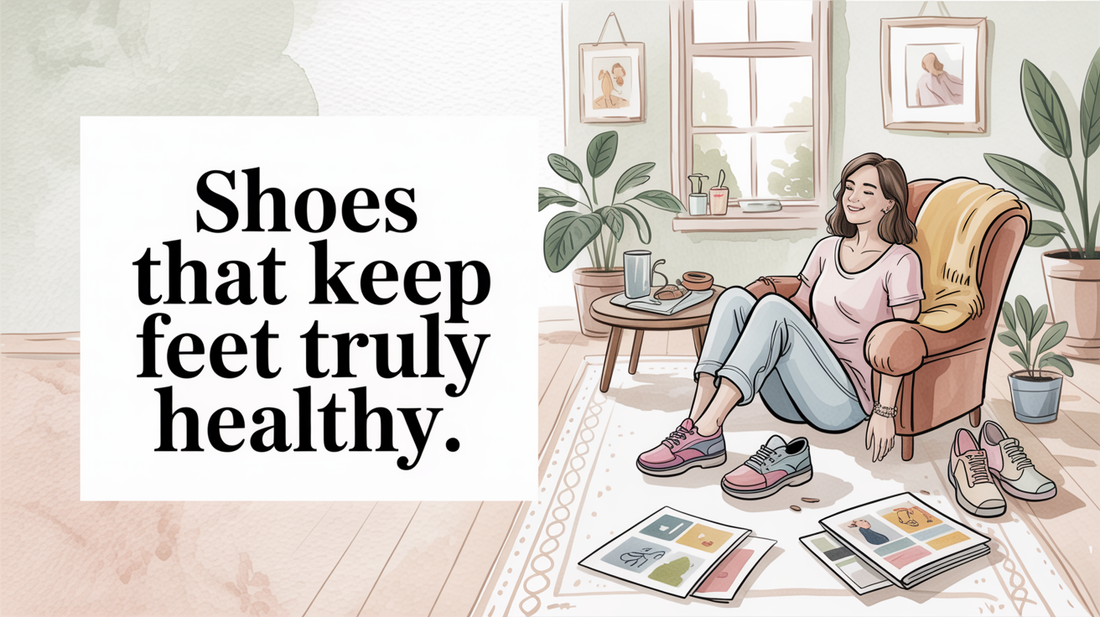What’s the best footwear for foot health?
healthy footwear, arch support, wide toe box — Finding the right footwear is essential for maintaining foot health. The right shoes can improve comfort and support, potentially preventing issues down the line. This blog post will explore three key elements of healthy footwear: fit and toe space, support and cushioning, and activity-specific picks, giving you actionable insights to enhance your footwear choices tonight.
Fit & toe space 🧭
Proper fit and adequate toe space are crucial for comfort and foot health. A shoe's toe box should allow for natural toe movement, preventing any crowding that could lead to discomfort. Ideally, there should be about a thumb's width of space between your longest toe and the front of the shoe, which is essential for daily comfort.
Choosing shoes with a wide toe box can help reduce the risk of bunions, hammertoes, and ingrown toenails. Remember, your feet swell throughout the day, so it's best to shop for shoes in the afternoon when your feet are at their largest. It's also wise to measure both feet, as they often differ in size, ensuring your shoes fit well.
- Look for a thumb's width of space between your longest toe and the shoe front.
- Opt for a wide toe box to prevent common foot issues.
- Shop for shoes in the afternoon when your feet are more swollen.
- Measure both feet to find the best fit.
- Ensure your toes can wiggle freely without restriction.
- Avoid pointed or narrow toe boxes that compress your toes.
Try It Tonight: Calm, Fresh Feet ✨
- Wash feet with warm water and mild cleanser; dry thoroughly between toes.
- Apply a small amount of Kissable Feet where needed; massage until absorbed.
- Let skin breathe; slip on breathable socks if desired. Patch-test first if you’re new to this foot cream.
Support & cushioning ✨
Having the right amount of support and cushioning is vital for maintaining proper foot alignment and comfort. Arch support can help maintain the natural curve of your foot, preventing issues related to overpronation or supination. Additionally, heel cushioning absorbs impact during walking, reducing stress on your joints and contributing to overall foot health.
Consider insoles with memory foam or gel, as they can offer customized comfort for pressure points. A firm heel counter also plays a significant role, preventing excessive movement of the foot and providing stability.
- Ensure your shoes offer adequate arch support for natural foot alignment.
- Look for heel cushioning to absorb impact and protect your joints.
- Choose shoes with midsole support for even weight distribution.
- Consider memory foam or gel insoles for personalized comfort.
- Opt for a firm heel counter to maintain stability during movement.
Why We Recommend a Gentle Helper 🌿
Kissable Feet is crafted for quick absorption and a soothing, non-sting feel. This nurse-crafted blend features tea tree, coconut, and calendula, which can provide comfort and a clean finish, making it easy to incorporate into your nighttime routine.
- Fast-absorbing comfort with a non-greasy finish.
- Gentle sensation suited for sensitive, overworked feet.
- Clean-leaning, bedtime-friendly scent.
Activity-specific picks 🔍
Different physical activities place varying demands on your feet, which means specific footwear features are necessary to optimize performance and prevent injury. Activity-specific shoes are designed with targeted support and protection, ensuring your feet are well cared for.
For running, look for maximum heel cushioning and motion control features. Walking shoes should offer firm heel support and moderate cushioning, while cross-training shoes need lateral stability and a firm midsole. Work boots should provide steel toe protection and slip-resistant soles, and dress shoes should have hidden arch support and cushioned insoles for comfort.
- Running shoes should focus on heel cushioning and flexibility.
- Walking shoes benefit from firm heel support and moderate cushioning.
- Cross-training shoes require lateral stability and a robust tread pattern.
- Work boots need safety features like steel toes and ankle support.
- Dress shoes should incorporate hidden arch support and a moderate heel height.

